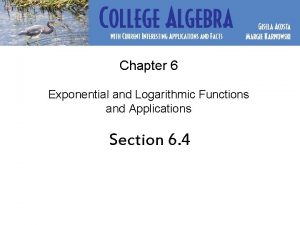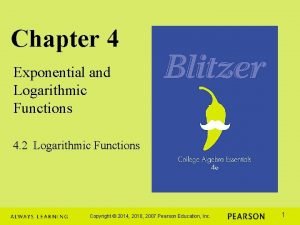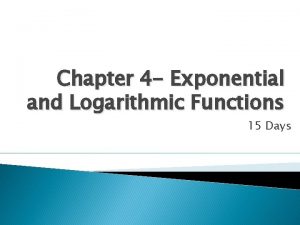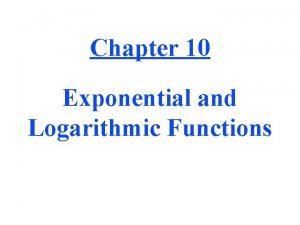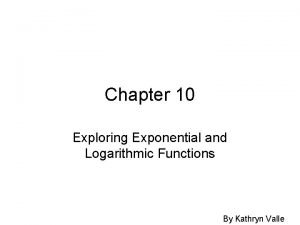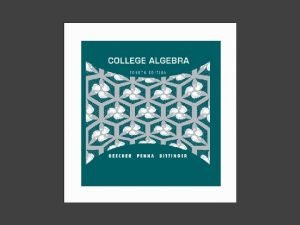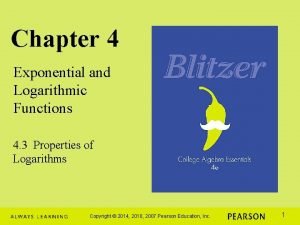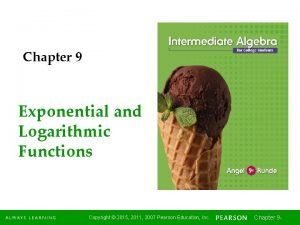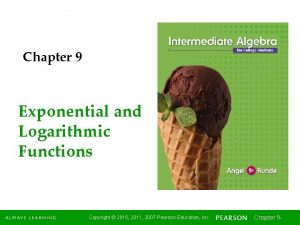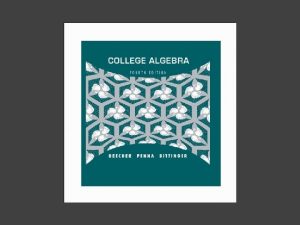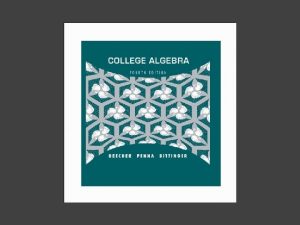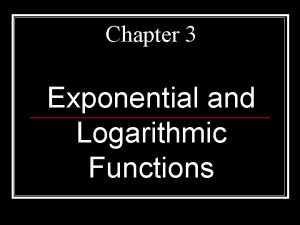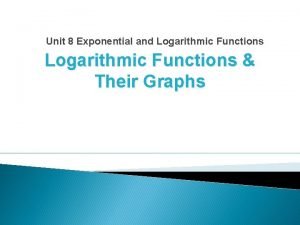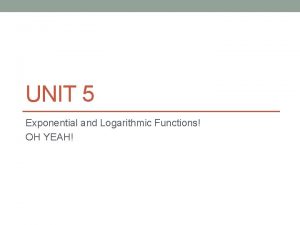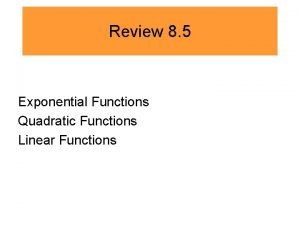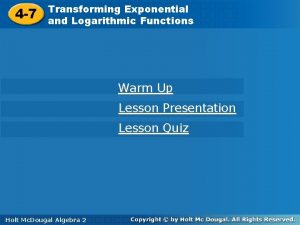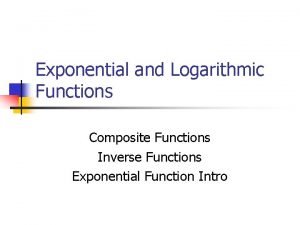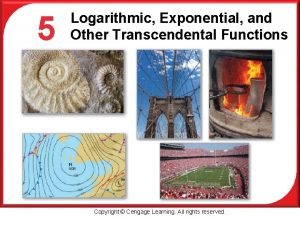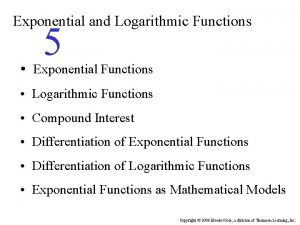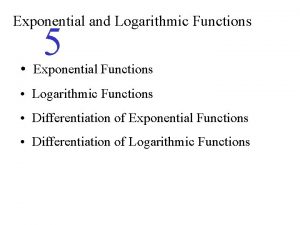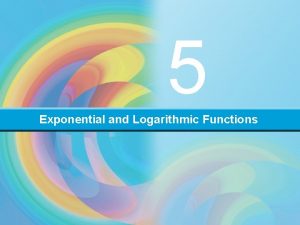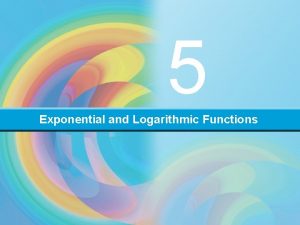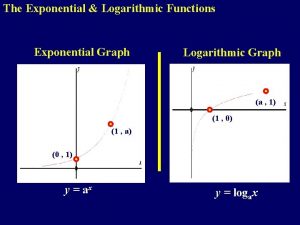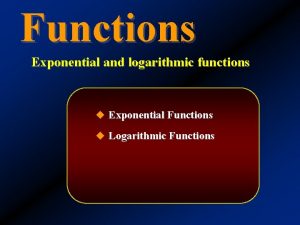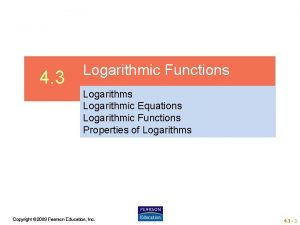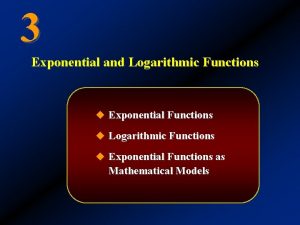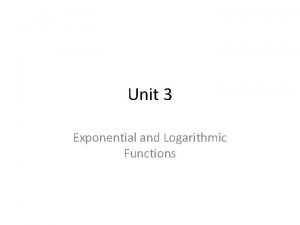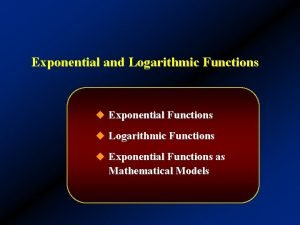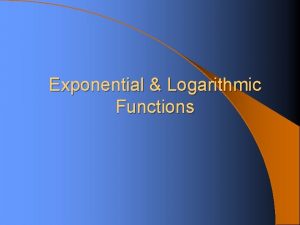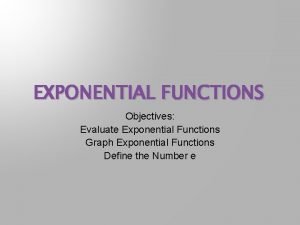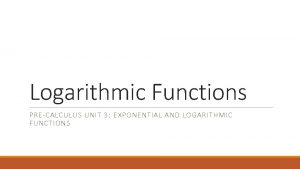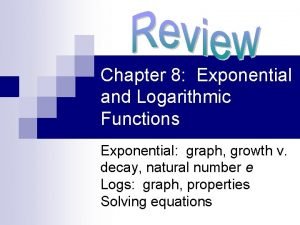Chapter 4 Exponential and Logarithmic Functions 4 3

















- Slides: 17

Chapter 4 Exponential and Logarithmic Functions 4. 3 Properties of Logarithms Copyright © 2014, 2010, 2007 Pearson Education, Inc. 1

Objectives: • • • Use the product rule. Use the quotient rule. Use the power rule. Expand logarithmic expressions. Condense logarithmic expressions. Use the change-of-base property. Copyright © 2014, 2010, 2007 Pearson Education, Inc. 2

The Product Rule Let b, M, and N be positive real numbers with b 1. The logarithm of a product is the sum of the logarithms. Copyright © 2014, 2010, 2007 Pearson Education, Inc. 3

Example: Using the Product Rule Use the product rule to expand each logarithmic expression: Copyright © 2014, 2010, 2007 Pearson Education, Inc. 4

The Quotient Rule Let b, M, and N be positive real numbers with b 1. The logarithm of a quotient is the difference of the logarithms. Copyright © 2014, 2010, 2007 Pearson Education, Inc. 5

Example: Using the Quotient Rule Use the quotient rule to expand each logarithmic expression: Copyright © 2014, 2010, 2007 Pearson Education, Inc. 6

The Power Rule Let b and M be positive real numbers with b 1, and let p be any real number. The logarithm of a number with an exponent is the product of the exponent and the logarithm of that number. Copyright © 2014, 2010, 2007 Pearson Education, Inc. 7

Example: Using the Power Rule Use the power rule to expand each logarithmic expression: Copyright © 2014, 2010, 2007 Pearson Education, Inc. 8

Properties for Expanding Logarithmic Expressions For M > 0 and N > 0: 1. Product Rule 2. Quotient Rule 3. Power Rule Copyright © 2014, 2010, 2007 Pearson Education, Inc. 9

Example: Expanding Logarithmic Expressions Use logarithmic properties to expand the expression as much as possible: Copyright © 2014, 2010, 2007 Pearson Education, Inc. 10

Example: Expanding Logarithmic Expressions Use logarithmic properties to expand the expression as much as possible: Copyright © 2014, 2010, 2007 Pearson Education, Inc. 11

Condensing Logarithmic Expressions For M > 0 and N > 0: 1. Product rule 2. Quotient rule 3. Power rule Copyright © 2014, 2010, 2007 Pearson Education, Inc. 12

Example: Condensing Logarithmic Expressions Write as a single logarithm: Copyright © 2014, 2010, 2007 Pearson Education, Inc. 13

The Change-of-Base Property For any logarithmic bases a and b, and any positive number M, The logarithm of M with base b is equal to the logarithm of M with any new base divided by the logarithm of b with that new base. Copyright © 2014, 2010, 2007 Pearson Education, Inc. 14

The Change-of-Base Property: Introducing Common and Natural Logarithms Introducing Common Logarithms Introducing Natural Logarithms Copyright © 2014, 2010, 2007 Pearson Education, Inc. 15

Example: Changing Base to Common Logarithms Use common logarithms to evaluate Copyright © 2014, 2010, 2007 Pearson Education, Inc. 16

Example: Changing Base to Natural Logarithms Use natural logarithms to evaluate Copyright © 2014, 2010, 2007 Pearson Education, Inc. 17
 Chapter 6 exponential and logarithmic functions answers
Chapter 6 exponential and logarithmic functions answers Chapter 4 exponential and logarithmic functions
Chapter 4 exponential and logarithmic functions Graphing logs and exponentials worksheet
Graphing logs and exponentials worksheet Chapter 10 exponential and logarithmic functions answers
Chapter 10 exponential and logarithmic functions answers Property of equality for exponential functions
Property of equality for exponential functions Lesson 5-2
Lesson 5-2 Expanding logarithmic functions
Expanding logarithmic functions Chapter 9 exponential and logarithmic functions answer key
Chapter 9 exponential and logarithmic functions answer key Chapter 9 exponential and logarithmic functions answer key
Chapter 9 exponential and logarithmic functions answer key Chapter 5 exponential and logarithmic functions answer key
Chapter 5 exponential and logarithmic functions answer key Chapter 5 exponential and logarithmic functions
Chapter 5 exponential and logarithmic functions Chapter 3 exponential and logarithmic functions
Chapter 3 exponential and logarithmic functions Unit 8 review logarithms
Unit 8 review logarithms Unit 5: exponential and logarithmic functions answers
Unit 5: exponential and logarithmic functions answers Quadratic linear exponential
Quadratic linear exponential Transforming exponential and logarithmic functions
Transforming exponential and logarithmic functions Reverse exponential graph
Reverse exponential graph Horizontal line test inverse
Horizontal line test inverse
